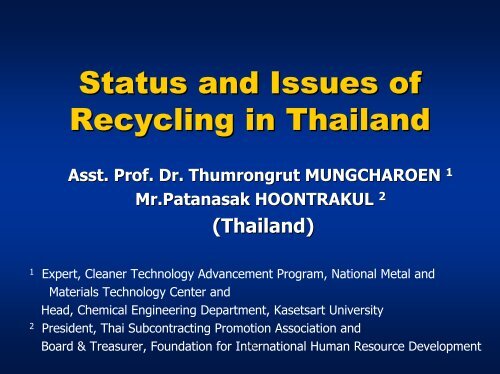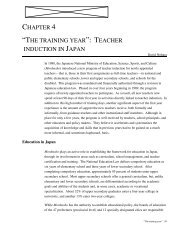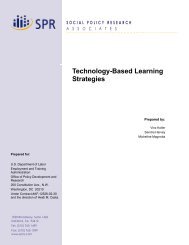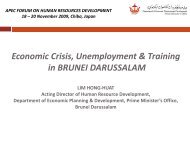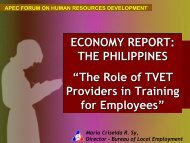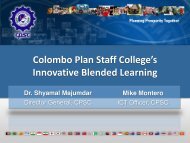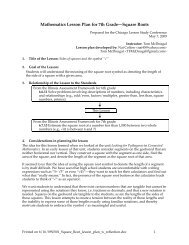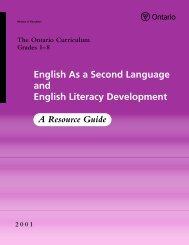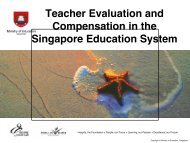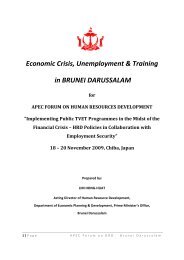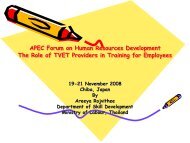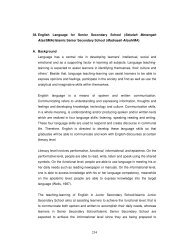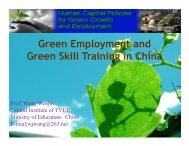Status and Issues of Recycling in Thailand
Status and Issues of Recycling in Thailand
Status and Issues of Recycling in Thailand
You also want an ePaper? Increase the reach of your titles
YUMPU automatically turns print PDFs into web optimized ePapers that Google loves.
<strong>Status</strong> <strong>and</strong> <strong>Issues</strong> <strong>of</strong><br />
<strong>Recycl<strong>in</strong>g</strong> <strong>in</strong> Thail<strong>and</strong><br />
Asst. Pr<strong>of</strong>. Dr. Thumrongrut MUNGCHAROEN 1<br />
Mr.Patanasak HOONTRAKUL 2<br />
(Thail<strong>and</strong>)<br />
1<br />
Expert, Cleaner Technology Advancement Program, National Metal <strong>and</strong><br />
Materials Technology Center <strong>and</strong><br />
Head, Chemical Eng<strong>in</strong>eer<strong>in</strong>g Department, Kasetsart University<br />
2<br />
President, Thai Subcontract<strong>in</strong>g Promotion Association <strong>and</strong><br />
Board & Treasurer, Foundation for International<br />
390<br />
Human Resource Development
Topics<br />
1. Current recycl<strong>in</strong>g system<br />
2. Legal framework <strong>and</strong><br />
government policies<br />
3. Industry practices<br />
4. <strong>Issues</strong> <strong>and</strong> problems<br />
391
1. Current recycl<strong>in</strong>g system <strong>in</strong> Thail<strong>and</strong><br />
From the study on “Thail<strong>and</strong> Energy Strategy <strong>and</strong> Policy” by Energy Research<br />
Institute, Chulalongkorn University:<br />
• Each year about 13 million tons <strong>of</strong> waste are generated<br />
(3 to 4 million tons or 30% is generated <strong>in</strong> Bangkok area)<br />
• <strong>Recycl<strong>in</strong>g</strong> is currently carried out by <strong>in</strong>dividuals <strong>and</strong> the <strong>in</strong>formal sector<br />
1. Residents source separate some recyclable materials <strong>and</strong> sell them directly<br />
to street buyers<br />
2. Waste collectors separate additional recyclable materials from garbage<br />
picked up from homes <strong>and</strong> bus<strong>in</strong>esses<br />
3. Pickers recover additional recyclable material at the l<strong>and</strong>fill<br />
• Larger bus<strong>in</strong>esses sell recyclable materials directly to junk shops <strong>and</strong> brokers<br />
Urban waste consists <strong>of</strong> about 40% organic material, 20% plastic, <strong>and</strong> 10% paper<br />
- Current <strong>in</strong>formal sector <strong>and</strong> various <strong>in</strong>formal arrangements recover an<br />
estimated 22% <strong>of</strong> the urban waste stream<br />
- No significant attempts to recycle the organic fraction <strong>of</strong> waste through<br />
compost<strong>in</strong>g or digestion<br />
392
1. Current recycl<strong>in</strong>g system <strong>in</strong> Thail<strong>and</strong> (cont.)<br />
• Rural waste is made up mostly <strong>of</strong> food scraps.<br />
- Food waste is fed to animals, <strong>and</strong> the rema<strong>in</strong>der is composted or dried for use as<br />
fuel<br />
- There is no organized disposal option for rural waste so litter<strong>in</strong>g has been reported<br />
as a problem <strong>in</strong> rural areas<br />
• Waste management plann<strong>in</strong>g has reached a critical po<strong>in</strong>t <strong>in</strong><br />
many area. Old l<strong>and</strong>fills are closed, <strong>and</strong> there is strong local<br />
resistance to construction <strong>of</strong> new l<strong>and</strong>fills<br />
• Energy Research Institute, Chulalongkorn University (2000) has proposed a<br />
comprehensive recycl<strong>in</strong>g strategy which <strong>in</strong>cludes the follow<strong>in</strong>g components:<br />
1. Increased recycl<strong>in</strong>g <strong>of</strong> dry materials from residential, commercial <strong>and</strong> <strong>in</strong>dustrial<br />
waste;<br />
2. Collection <strong>and</strong> compost<strong>in</strong>g or digestion <strong>of</strong> organic waste from<br />
residential, commercial <strong>and</strong> <strong>in</strong>dustrial sources;<br />
3. Manufacture <strong>of</strong> a refuse derived fuel (RDF) from some portions <strong>of</strong> the garbage<br />
stream;<br />
4. M<strong>and</strong>atory source separation <strong>of</strong> recyclable, compostable <strong>and</strong> reusable material<br />
393<br />
for commercial <strong>and</strong> <strong>in</strong>dustrial waste generators;
1. Current recycl<strong>in</strong>g system <strong>in</strong> Thail<strong>and</strong><br />
(cont.)<br />
5. M<strong>and</strong>atory source separation <strong>of</strong> recyclable <strong>and</strong> compostable material<br />
from urban waste collected by municipal crews;<br />
6. Implementation <strong>of</strong> a user pay policy for waste collected by municipal<br />
forces;<br />
7. Implementation <strong>of</strong> user fees (tipp<strong>in</strong>g fees) for waste disposal at l<strong>and</strong>fills;<br />
8. <strong>Recycl<strong>in</strong>g</strong> <strong>and</strong> community compost<strong>in</strong>g <strong>of</strong> rural waste;<br />
9. Extensive <strong>and</strong> on-go<strong>in</strong>g public education campaigns target<strong>in</strong>g the<br />
requirements <strong>of</strong> the new source separation systems;<br />
10. A national recycl<strong>in</strong>g target <strong>of</strong> 50%, to be achieved by the year 2008;<br />
11. New legislation on m<strong>and</strong>atory source separation <strong>of</strong> materials by<br />
residents <strong>and</strong> bus<strong>in</strong>esses throughout Thail<strong>and</strong>;<br />
12. New anti-litter legislation;<br />
13. Consultation with the public <strong>and</strong> <strong>in</strong>dustry on long term f<strong>in</strong>anc<strong>in</strong>g <strong>of</strong> the<br />
waste management system, <strong>and</strong> an appropriate role for <strong>in</strong>dustry <strong>in</strong><br />
394<br />
provid<strong>in</strong>g f<strong>in</strong>ancial support.
1. Current recycl<strong>in</strong>g system <strong>in</strong> Thail<strong>and</strong><br />
(cont.)<br />
• Thail<strong>and</strong> Environment Institute (TEI) has established a “Material<br />
Exchange Center” (MEC), a web-based center, to serve as a<br />
neutral body <strong>in</strong> coord<strong>in</strong>at<strong>in</strong>g the needs <strong>of</strong> factories or<br />
companies that have waste or discarded materials for recycl<strong>in</strong>g<br />
<strong>and</strong> those <strong>in</strong> need <strong>of</strong> materials for recycl<strong>in</strong>g<br />
- <strong>Recycl<strong>in</strong>g</strong> one ton <strong>of</strong> alum<strong>in</strong>um saves the energy equivalent <strong>of</strong> 2,350<br />
gallons <strong>of</strong> gasol<strong>in</strong>e.<br />
- Every ton <strong>of</strong> steel recycled saves 2500 pounds <strong>of</strong> iron ore, 1400 pounds<br />
<strong>of</strong> coal <strong>and</strong> 120 pounds <strong>of</strong> lime stone<br />
- <strong>Recycl<strong>in</strong>g</strong> paper produces 73 percent less air pollution than does<br />
manufactur<strong>in</strong>g paper from virg<strong>in</strong> materials, while recycl<strong>in</strong>g glass cuts<br />
down on m<strong>in</strong><strong>in</strong>g wastes from glass manufactur<strong>in</strong>g by 80 percent<br />
http://www.tei.or.th/mec/<br />
395
Amount <strong>of</strong> Industry <strong>and</strong> Community waste <strong>and</strong> % recycle<br />
Industries<br />
Amount <strong>of</strong> Industrial<br />
<strong>and</strong> Community<br />
waste (tons/yr)<br />
Amount <strong>of</strong> Useful<br />
waste<br />
tons<br />
%<br />
Method<br />
paper<br />
3,139,000<br />
1,024,000<br />
32<br />
Recycle<br />
glass<br />
1,756,000<br />
730,000<br />
41<br />
Recycle<br />
180,000<br />
10<br />
Reuse<br />
plastic<br />
2,930,000<br />
674,000<br />
23<br />
Recycle<br />
steel<br />
28,552,000<br />
2,288,000<br />
80<br />
Recycle<br />
Alum<strong>in</strong>um<br />
276,000<br />
135,000<br />
49<br />
Recycle<br />
Tire<br />
358,000<br />
41<br />
11<br />
Recycle<br />
396<br />
35,000<br />
10<br />
Reuse
80<br />
70<br />
60<br />
%<br />
50<br />
40<br />
30<br />
20<br />
current (%)<br />
expected(%)<br />
10<br />
0<br />
glass<br />
paper<br />
plastic<br />
steel<br />
Alum<strong>in</strong>ium<br />
Tyre<br />
Expected % recycle <strong>of</strong> Thail<strong>and</strong><br />
397
Total Consumption <strong>in</strong> Thail<strong>and</strong><br />
1.2<br />
Ouantities (Million Units)<br />
1<br />
0.8<br />
0.6<br />
0.4<br />
0.2<br />
0<br />
1997 1998 1999 2000 2001<br />
TV Air Con. Refrig. Comp. Monitor<br />
Year<br />
398
2. Legal framework <strong>and</strong> government policies<br />
<br />
<br />
9 th National Economic <strong>and</strong> Social Development<br />
Plan (2002-2006)<br />
2006)<br />
Support<strong>in</strong>g the segregation, take back <strong>and</strong> recovery<br />
<strong>of</strong> wastes at least 30%<br />
Promot<strong>in</strong>g the waste recovery <strong>and</strong> cleaner technology<br />
(CT)<br />
Measures<br />
Promote CT for the eco-efficiency efficiency <strong>in</strong> manufactur<strong>in</strong>g<br />
sector to reduce raw materials, energy <strong>and</strong> pollution<br />
as well as <strong>in</strong>crease the 3R efficiency <strong>and</strong> resource use<br />
potential, such as design for long-life life product, design<br />
<strong>of</strong> zero emission product, etc.<br />
Control the production <strong>of</strong> packag<strong>in</strong>g <strong>in</strong> order to<br />
reduce/select materials <strong>and</strong> <strong>in</strong>crease 3R<br />
Promote the material/waste exchange center <strong>in</strong> the<br />
manufactur<strong>in</strong>g sector 399
Target <strong>of</strong> pilot study <strong>in</strong><br />
Thail<strong>and</strong>’s s Municipality<br />
Lampang<br />
Municipality<br />
1. Reduce the amount <strong>of</strong> waste <strong>and</strong> trash by<br />
10% <strong>in</strong> the first year <strong>and</strong> then <strong>in</strong>crease to<br />
20% with<strong>in</strong> 5 years by the project <strong>of</strong> pick<strong>in</strong>g<br />
out waste <strong>and</strong> trash from 6 schools under<br />
the Department <strong>of</strong> Education<br />
Nonthaburi<br />
Municipality<br />
1. Recycle 20% <strong>of</strong> collected household waste<br />
by 2005<br />
1. Increase green area by 20% by 2005<br />
400
Strategy on WEEE & RoHS<br />
<br />
<br />
<br />
<br />
<br />
Set up a work<strong>in</strong>g committee to follow up <strong>and</strong> assess the effect <strong>of</strong><br />
these directives. There are 5 groups <strong>of</strong> products: 1) Computers<br />
<strong>and</strong> Electronics 2) Household Electrical Appliances 3) Light<strong>in</strong>gs<br />
4) Medical Equipments 5) Others (Toys, etc.)<br />
Raise awareness to <strong>in</strong>dustries especially SMEs<br />
Study the appropriate measures to implement<br />
Improve Law & Regulations to comply with those <strong>in</strong>ternational<br />
regulations<br />
Set up an Early Warn<strong>in</strong>g System for other directives to come<br />
Future Tasks on WEEE & RoHS<br />
<br />
<br />
<br />
<br />
Create <strong>and</strong> support to launch the appropriate take back system<br />
<strong>of</strong> WEEE<br />
Develop <strong>and</strong> issue the restricted law <strong>and</strong> regulation to control the t<br />
discard, 3R <strong>and</strong> f<strong>in</strong>al disposal <strong>of</strong> WEEE<br />
Promote 3R <strong>and</strong> material/waste exchange to manufacturer<br />
Establish the Central WEEE Management Facilities for<br />
segregation, reuse, recycle, recovery, treatment <strong>and</strong> f<strong>in</strong>al<br />
401<br />
disposal
Relevant projects/programmes<br />
programmes<br />
Department <strong>of</strong> Foreign Trade<br />
- Study on the Impacts <strong>of</strong> Directive on WEEE <strong>and</strong> RoHS to Thai Industries <strong>and</strong> the<br />
WEEE Management Guide (studied by EEI/ TEI/ MTEC/ KU/ CU) … 2003<br />
Thail<strong>and</strong> Environment Institute (TEI)<br />
- Study <strong>and</strong> promote “Waste Exchange” to <strong>in</strong>dustry section<br />
National Metal <strong>and</strong> Materials Technology Center (MTEC)<br />
- Study on the substitution <strong>of</strong> Hz substance use <strong>in</strong> the EEE (2003-now)<br />
- Green Manufactur<strong>in</strong>g Technical Assistance Program (under Green Aid A<br />
Plan) on<br />
LCA, Ecodesign <strong>and</strong> <strong>Recycl<strong>in</strong>g</strong> Technology (2002-now)<br />
- Research <strong>and</strong> Promotion <strong>of</strong> CT, LCA, Ecodesign, , <strong>and</strong> <strong>Recycl<strong>in</strong>g</strong><br />
(project on LCA <strong>of</strong> Rotary compressor/ LCA <strong>of</strong> Refrigerator/ Eco-Compressor/ etc.)<br />
NEPO (National Energy Policy Office)<br />
- Study on “Integration <strong>of</strong> <strong>Recycl<strong>in</strong>g</strong> <strong>in</strong>to the Energy Conservation Plan” (2000)<br />
Pollution Control Department (PCD)<br />
- The establishment <strong>of</strong> the appropriate br<strong>in</strong>g/buy back system for WEEE<br />
- Draft the regulation on hazardous waste management on the basis <strong>of</strong> deposit-<br />
refund system<br />
- Technical guidel<strong>in</strong>e on WEEE Management (overview, fluorescent lamp, l<br />
monitor)<br />
402<br />
Department <strong>of</strong> Industrial Works (DIW)<br />
- FS on WEEE Recycle Plant
3. Industry Practices<br />
3.1 Toyota, Thail<strong>and</strong><br />
Th<strong>in</strong>ner<br />
Steel scrap<br />
From press<strong>in</strong>g<br />
Wood, paper<br />
Recycle<br />
factory<br />
• Redesign for smallest steel scrap<br />
• Recycle <strong>of</strong> plastic: Cut to small pieces Load<strong>in</strong>g Recycle<br />
• Th<strong>in</strong>ner reused<br />
403<br />
• Recycle Fluorescence Bulbs
3. Industry Practices<br />
3.2 Michel<strong>in</strong> Siam Group Co.,Ltd.<br />
Used Tire <strong>Recycl<strong>in</strong>g</strong> Project<br />
a jo<strong>in</strong>t project between the 3 major tire manufacturers <strong>of</strong> Thail<strong>and</strong><br />
<strong>and</strong><br />
(Michel<strong>in</strong> Siam Group + Goodyear Thail<strong>and</strong> + Bridgestone NRC)<br />
Total production capacity <strong>of</strong> 25.5 million pieces annually. In 2001, 2<br />
the actual production <strong>of</strong> ~ 19.7 million tires (domestic 11.6 million,<br />
lion,<br />
export 8.1 million)<br />
Used Tire <strong>Recycl<strong>in</strong>g</strong> Project<br />
Today, fewer <strong>and</strong> fewer used tires are end<strong>in</strong>g up <strong>in</strong> l<strong>and</strong>fill or dumps d<br />
as new recycl<strong>in</strong>g possibilities are developed <strong>and</strong> more people<br />
become aware <strong>of</strong> the ecological stakes <strong>in</strong>volved.<br />
Michel<strong>in</strong> is committed to the fight to protect the environment <strong>and</strong><br />
actively participates <strong>in</strong> the common movement with<strong>in</strong> the tire <strong>in</strong>dustry<br />
to encourage end-<strong>of</strong><br />
<strong>of</strong>-life tire recycl<strong>in</strong>g<br />
<strong>Recycl<strong>in</strong>g</strong> rates <strong>in</strong> 2002: Western Europe 73%, Japan 87%, North<br />
America 85%, Brazil 31%<br />
(Sources - BLIC, RMA, JATMA.) 404
Used Tire <strong>Recycl<strong>in</strong>g</strong> Project<br />
The ma<strong>in</strong> challenge is the creation <strong>and</strong> management <strong>of</strong> genu<strong>in</strong>e e solutions for collect<strong>in</strong>g<br />
<strong>and</strong> recycl<strong>in</strong>g end-<strong>of</strong><br />
<strong>of</strong>-life tires<br />
1. Energy recovery: : An end-<strong>of</strong><br />
<strong>of</strong>-life tire represents an amount <strong>of</strong> heat energy comparable<br />
to that <strong>of</strong> good-quality coal: 30 to 34 MJ/kg. So one tonne <strong>of</strong> tires yields the same<br />
energy as 0.7 tonne <strong>of</strong> oil.The low level <strong>of</strong> sulfur (1%) conta<strong>in</strong>ed <strong>in</strong> tires compared<br />
with certa<strong>in</strong> types <strong>of</strong> coal (5%) make them a substitute fuel with less impact on the<br />
environment.<br />
2. Material recovery: Michel<strong>in</strong> considers non-reusable end-<strong>of</strong><br />
<strong>of</strong>-life tires to be recyclable<br />
items <strong>and</strong> is do<strong>in</strong>g its utmost to change their image as waste, by develop<strong>in</strong>g their<br />
reuse <strong>in</strong> various forms.<br />
3. Whole tires: : These are used as fill<strong>in</strong>g material for roads, reta<strong>in</strong><strong>in</strong>g structures, ures, noise-<br />
abatement walls <strong>and</strong> as shock absorbers along jetties <strong>and</strong> quaysides.<br />
4. Cut tires: : Cut tires are widely used as a support<strong>in</strong>g layer for rail tracks s to reduce noise<br />
<strong>and</strong> vibration.<br />
5. Shredded tires: : In shredded form, they are ma<strong>in</strong>ly used as dra<strong>in</strong><strong>in</strong>g sub-layers or as<br />
light fill<strong>in</strong>g material <strong>in</strong> road construction.<br />
6. Granulate <strong>and</strong> powder: : When ground <strong>in</strong>to a granulate or powder, tires are used to<br />
make molded objects such as refuse conta<strong>in</strong>ers <strong>and</strong> golf cart wheels. The powdered<br />
form can also be used to make surfaces for sports activities: stadiums, playground<br />
surfaces, etc. Similarly, the addition <strong>of</strong> powdered 405 rubber to road d surfaces helps to<br />
reduce tire/road contact noise <strong>and</strong> <strong>in</strong>crease the life span <strong>of</strong> the surface.
3. Industry Practices<br />
3.3 Siam Cement Group<br />
<strong>Recycl<strong>in</strong>g</strong> <strong>and</strong> Green<strong>in</strong>g the Supply Cha<strong>in</strong><br />
Raw material supplier<br />
F<strong>in</strong>al products manufacturer<br />
End user<br />
- Just started “Green Procurement Project” <strong>in</strong> 2004: set up ma<strong>in</strong><br />
406<br />
criteria us<strong>in</strong>g LCA concept with social & environmental management
Tons<br />
600000<br />
500000<br />
Management<br />
Siam Cement Group: 2001-<br />
87,012<br />
2003<br />
15.70 %<br />
Reuse/RecycleWith<strong>in</strong><br />
RecycleOutside<br />
(Ref.slide 9)<br />
400000<br />
300000<br />
200000<br />
100000<br />
0<br />
467,322<br />
84.30 %<br />
77,065<br />
180,907<br />
29.87 %<br />
70.13 %<br />
297,319<br />
213,098<br />
2001<br />
407<br />
2002 2003<br />
58.25<br />
41.75<br />
Year
3. Industry Practices<br />
3.4 3R <strong>of</strong> used computers<br />
Ma<strong>in</strong> Components <strong>of</strong> Computers:<br />
CPU, Monitor, Keyboard, Speakers <strong>and</strong> Mouse<br />
Copper<br />
7.0%<br />
Lead<br />
6.3%<br />
Others<br />
0.3%<br />
Glass<br />
24.9%<br />
Alum<strong>in</strong>ium<br />
14.2%<br />
Plastic<br />
22.8%<br />
Iron<br />
24.5%<br />
408<br />
Components by types <strong>of</strong> material
3.4 3R <strong>of</strong> used computers (Cont.)<br />
There are ~ 927,850 computers <strong>in</strong> Thail<strong>and</strong> <strong>in</strong> 2001<br />
- 890,300 Desktops <strong>and</strong> 37,550 Laptops (Notebooks)<br />
(average 5.75 sets per 100 households)<br />
<br />
<br />
Potential for Recycle <strong>of</strong> used computers<br />
Group 1: High (> 80%) - Alum<strong>in</strong>um, Iron, Nickel, Gold, Silver<br />
Group 2: Moderate (50~80%) - Z<strong>in</strong>c, Indium, Sil<strong>in</strong>ium, Rhodium<br />
Group 3: Low (
3. Industry Practices<br />
3.5 Recycle <strong>of</strong> WEEE <strong>in</strong> Thail<strong>and</strong><br />
Type <strong>of</strong><br />
product<br />
Life time <strong>of</strong> WEEE (year)<br />
Thail<strong>and</strong><br />
Japan<br />
(METI 2002)<br />
Japan Off <strong>of</strong><br />
Secretariat <strong>of</strong><br />
Cab<strong>in</strong>et 2002<br />
Japan Tokyo<br />
Metro 1998<br />
TV 18.6 12.5 10.23 13.95<br />
Refrigerator 15.1 13.5 11.48 14.58<br />
Wash<strong>in</strong>g 11.9 11.2 9.03 11.95<br />
M/C<br />
A/C Indoor 9.24 13.8 - 13.71<br />
A/C Outdoor 8.85 13.8 12.55 15.20<br />
410<br />
Source: Survey <strong>of</strong> the WEEE <strong>in</strong> Thail<strong>and</strong> , June 2004 (for PC: 7 years, CRT: 9.27 years)
3. Industry Practices<br />
3.5 Recycle <strong>of</strong> WEEE <strong>in</strong> Thail<strong>and</strong><br />
No.<br />
1<br />
2<br />
3<br />
4<br />
5<br />
6<br />
7<br />
Type <strong>of</strong> WEE<br />
TV<br />
Refrigerator<br />
Wash<strong>in</strong>g<br />
Mach<strong>in</strong>e<br />
A/C Indoor<br />
A/C Outdoor<br />
PC<br />
CRT Screen<br />
Average weight<br />
(kg/unit)<br />
17.45<br />
40.37<br />
45.48<br />
35.10<br />
40.59<br />
6.79<br />
13.61<br />
Recyclable<br />
rate (%)<br />
31<br />
92<br />
71<br />
100<br />
100<br />
100<br />
100<br />
Non-recyclable<br />
rate (%)<br />
411<br />
Source: Survey conducted by dismantl<strong>in</strong>g the parts <strong>of</strong> the WEEE, 10 units for each category<br />
69<br />
8<br />
29<br />
0<br />
0<br />
0<br />
0
4. <strong>Issues</strong> <strong>and</strong> problems<br />
• Wastes <strong>in</strong> Thail<strong>and</strong> currently <strong>in</strong>crease ~10%<br />
each year<br />
• Very difficult to separate “Useful waste” from<br />
“Municipal wastes”<br />
• Lack <strong>of</strong> a specific regulation or measure for<br />
the management <strong>of</strong> waste<br />
• Lack <strong>of</strong> high technology Recycle factory<br />
• Poor f<strong>in</strong>ancial support on waste management<br />
as reflected <strong>in</strong> the budget allocation each year<br />
• Lack <strong>of</strong> expertise, technologies <strong>and</strong> facilities<br />
412
Problems<br />
How to reduce waste/ garbage<br />
• Lack <strong>of</strong> public awareness<br />
• Lack <strong>of</strong> promotion activities<br />
• Laws <strong>and</strong> regulations are not adequate to protect<br />
export <strong>of</strong> low quality products (generate more<br />
wastes)<br />
How to segregate waste/ garbage<br />
• Lack <strong>of</strong> public awareness<br />
• No formal/systematic waste or garbage<br />
separation/ segregation<br />
• Goods/ products sold didn’t t design to easy<br />
disassemble/ recycle<br />
How to reuse/ recycle<br />
• Lack <strong>of</strong> expertise <strong>and</strong> research<br />
• Lack <strong>of</strong> support/ commitment from the government<br />
• Lack <strong>of</strong> technologies <strong>and</strong> fund<strong>in</strong>g<br />
413
Problems/Constra<strong>in</strong>ts for WEEE<br />
• Rapid growth <strong>of</strong> EEE Production <strong>and</strong> Use <strong>in</strong> Thail<strong>and</strong> has<br />
resulted <strong>in</strong> a major <strong>in</strong>crease <strong>in</strong> the quantity <strong>of</strong> WEEE<br />
• Hazard content <strong>of</strong> WEEE is <strong>of</strong> concern <strong>and</strong> cause the<br />
environmental problem<br />
• Illegal import <strong>of</strong> WEEE <strong>in</strong> the term <strong>of</strong> second h<strong>and</strong> products for<br />
sale or reuse are the environmental <strong>and</strong> f<strong>in</strong>ancial burden<br />
• 90% <strong>of</strong> WEEE is currently disposed together with municipal solid<br />
wastes without pre-treatment (recycl<strong>in</strong>g by <strong>in</strong>formal sectors)<br />
• Lack <strong>of</strong> a specific regulation or measure for the management <strong>of</strong><br />
WEEE (No law on take back system, No law on WEEE recycl<strong>in</strong>g)<br />
• No agency directly responsible for take back system <strong>and</strong><br />
recycl<strong>in</strong>g (there are only organizations for the environment)<br />
• Lack <strong>of</strong> expertise, technologies <strong>and</strong> facilities.<br />
414
References<br />
• Kokusai Kogyo (Thail<strong>and</strong>), “The Field Survey on the<br />
Discharge <strong>of</strong> WEEE”, June 2004<br />
• Siam Cement Group, “Susta<strong>in</strong>ability Report 2003”.<br />
• Thail<strong>and</strong> Environmental Institute, Proceed<strong>in</strong>g on<br />
“Waste <strong>and</strong> Energy Management: How Bus<strong>in</strong>ess<br />
should adjust”, December 2003.<br />
• http://www.tei.or.th/mec/<br />
• http://www.runsnroses.com/<strong>in</strong>formation/recycle.htm<br />
415


